
I don’t know what the reports say in the Farmer’s Almanac of 1932 regarding storms – but, at least according to the animated world, they were in abundance that year. Nearly every forecast was for rain, with a near-equal split of squalls between land and sea. Animation was growing in sophistication, with many of these downpours depicted quite elaborately – some even in color. So, break out your waterproof slickers, and try not to let the spray wash these letters off the virtual pages, as we dive in up to our necks for a soaking,
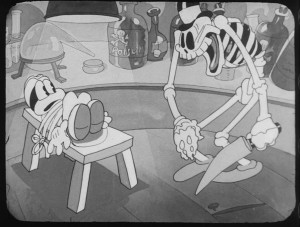 Spooks (Ub Iwerks/MGM, Flip the Frog, 3/5/32) – Included here for some more moody atmospherics which begin the film, as Flip and an old horse (who looks conspicuously like Horace Horsecollar) buck the winds of a raging thunderstorm in a dark night, in search of shelter. The wind blows so fiercely, Flip is blown right off his saddle, dangling in the gale from the hairs of his horse’s tail. They encounter an old shed, and duck behind its walls, only to have the whole shed picked up and blown away by the storm’s force, leaving them in the open again. A mysterious dark house, also being bent and stretched by the blow, comes into view ahead of them. Flip knocks, leaving his horse outside, as a foreboding shadow and menacing laugh are seen and heard within the house’s window. Flip cautiously enters the opening door, and is greeted by – a skeleton butler, who locks the door, gives him a low bow, then disappears in the flash of a thunderbolt from outside. Flip runs in a panic through the house’s darkness, encountering the master of the house, a skeleton in a top hat, seated at a table. “Stop. You’re just in time to dine”, commands the skeleton. “Yes, Ma’am”, answers a nervous Flip. The butler enters the room on command, serving the specialty of the house – steaming hot roast chicken skeleton. The stage is set for a spooky party, in which Iwerks pulls out all the stops, trotting out his skill in anatomical drawing with a skeletal cast rivaling his own “The Skeleton Dance”, while also copycatting several elements of Disney’s “The Haunted House”.
Spooks (Ub Iwerks/MGM, Flip the Frog, 3/5/32) – Included here for some more moody atmospherics which begin the film, as Flip and an old horse (who looks conspicuously like Horace Horsecollar) buck the winds of a raging thunderstorm in a dark night, in search of shelter. The wind blows so fiercely, Flip is blown right off his saddle, dangling in the gale from the hairs of his horse’s tail. They encounter an old shed, and duck behind its walls, only to have the whole shed picked up and blown away by the storm’s force, leaving them in the open again. A mysterious dark house, also being bent and stretched by the blow, comes into view ahead of them. Flip knocks, leaving his horse outside, as a foreboding shadow and menacing laugh are seen and heard within the house’s window. Flip cautiously enters the opening door, and is greeted by – a skeleton butler, who locks the door, gives him a low bow, then disappears in the flash of a thunderbolt from outside. Flip runs in a panic through the house’s darkness, encountering the master of the house, a skeleton in a top hat, seated at a table. “Stop. You’re just in time to dine”, commands the skeleton. “Yes, Ma’am”, answers a nervous Flip. The butler enters the room on command, serving the specialty of the house – steaming hot roast chicken skeleton. The stage is set for a spooky party, in which Iwerks pulls out all the stops, trotting out his skill in anatomical drawing with a skeletal cast rivaling his own “The Skeleton Dance”, while also copycatting several elements of Disney’s “The Haunted House”.
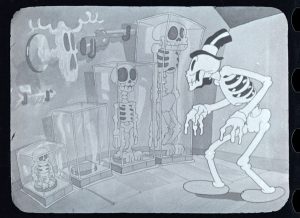 He adds a few new twists, including a skeleton dog (to which Flip tries to give away the chicken bones he can’t consume himself), who makes a delightful pre-code entrance, raising a leg as if about to urinate, but then shifting action to merely scratch himself to remove a skeleton flea. Iwerks also throws in a female skeleton for Flip’s dancing partner in an apache dance (a design no doubt inspired by the Spanish skeleton dancer who briefly appeared in Tom and Jerry’s “Wot a Night”). Flip’s host, however, has a hidden agenda. A secret room reveals that he is a collector of animal skeletons, with one display case just Flip’s size still vacant. Flip is invited to spend the night, and is magically transformed from his street clothes into a nightshirt and cap. Just before settling down to bed, Flip searches under it, presumably looking for a chamber pot, but finds none. He whispers to the skeleton, obviously inquiring if there is a restroom. The skeleton points to a door down the hall, with a sign posted on it reading “This is it.” Flip enters, only to be waylaid inside by the skeleton, who has beaten him inside through an undisclosed entrance. When the lights go on, Flip is tied to a table, and the skeleton is sharpening a carving knife, prepared to shear Flip of his unneeded skin. (The most horrific aspect of this scene is that Flip is put into peril at a time when he really needs to go to the bathroom!) Flip somehow manages to do just what his name suggests – and flips over the table, so that he can crawl away while his waist is still tied to the table above him. The skeleton pursues, and Flip dives down a staircase, encountering several skeletons whom he disassembles with the impact of his table. The rope breaks, and Flip is freed, beating a hasty exit through the front door, and mounting up on his waiting steed. As the horse trots off into the darkened countryside, Flip looks back to give the skeletons the raspberry – but when he looks again at the horse, a transformation has taken place, converting the horse intio a skeleton too. (Another idea borrowed from “Wot a Night”?) Flip dismounts in a hurry, leaving the horse behind, and disappears over a hill in the background at full run, for the iris out.
He adds a few new twists, including a skeleton dog (to which Flip tries to give away the chicken bones he can’t consume himself), who makes a delightful pre-code entrance, raising a leg as if about to urinate, but then shifting action to merely scratch himself to remove a skeleton flea. Iwerks also throws in a female skeleton for Flip’s dancing partner in an apache dance (a design no doubt inspired by the Spanish skeleton dancer who briefly appeared in Tom and Jerry’s “Wot a Night”). Flip’s host, however, has a hidden agenda. A secret room reveals that he is a collector of animal skeletons, with one display case just Flip’s size still vacant. Flip is invited to spend the night, and is magically transformed from his street clothes into a nightshirt and cap. Just before settling down to bed, Flip searches under it, presumably looking for a chamber pot, but finds none. He whispers to the skeleton, obviously inquiring if there is a restroom. The skeleton points to a door down the hall, with a sign posted on it reading “This is it.” Flip enters, only to be waylaid inside by the skeleton, who has beaten him inside through an undisclosed entrance. When the lights go on, Flip is tied to a table, and the skeleton is sharpening a carving knife, prepared to shear Flip of his unneeded skin. (The most horrific aspect of this scene is that Flip is put into peril at a time when he really needs to go to the bathroom!) Flip somehow manages to do just what his name suggests – and flips over the table, so that he can crawl away while his waist is still tied to the table above him. The skeleton pursues, and Flip dives down a staircase, encountering several skeletons whom he disassembles with the impact of his table. The rope breaks, and Flip is freed, beating a hasty exit through the front door, and mounting up on his waiting steed. As the horse trots off into the darkened countryside, Flip looks back to give the skeletons the raspberry – but when he looks again at the horse, a transformation has taken place, converting the horse intio a skeleton too. (Another idea borrowed from “Wot a Night”?) Flip dismounts in a hurry, leaving the horse behind, and disappears over a hill in the background at full run, for the iris out.
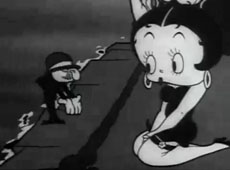 Swim or Sink (Fleischer,/Paramount, Talkartoon (Betty Boop), 3/11/32 – Dave Fleischer, dir., Seymour Kneitel/Bernard Wolf, anim.) – An ocean liner is in distress at sea. Lightning bolts strike it from both bow and stern. A large wave gives the ship a flip, upsetting the elements of its superstructure, which fall back into place much like a stack of pancakes, deck by deck, followed by smokestacks, then finally, the smoke. Rain-soaked clouds bash head-on into each other above, the voltage of their Impact causing a lightning-bolt shaped crack to appear in the darkened sky. A helpful bolt of electricity appears with needle and thread, to sew the sky back together. More lightning causes the ship to briefly duck under water, its stern rising again above the waves, with a face gasping for air. As the ship resurfaces, we meet its passengers on deck. A huge male hippo stops a mob of passengers heading for the lifeboats in their tracks, and reminds them of the old nautical rule, “Women and children first.” Unashamedly before them, he dons a woman’s blonde wig, and a juvenile bow, then leaps himself into the lifeboat, knocking a hole through its bottom and falling into the sea. A pig emerges from a state room, and is about to dive overboard, when he stops to remember something, then pulls out a book, beginning at page 1 of a volume entitled, “How To Swim”. A dog in another room notes the storm outside, grabs a life preserver, and dives out the porthole. A mouse appears at his table, announcing he wants to go swimming too, and joins him, grabbing a doughnut as his own preserver. Not all preservers are created equal, as another passenger, already in the sea, spots one floating by, puts it on – then umexplainedly sinks like a stone. Another animal seems to find a floatation device in the water, but in reality has wedged his head between the humps of a partially-submerged camel. A giraffe swims against the current, and a huge wave crashes over him. He emerges on the other side with about seven other passengers clinging to his neck, one a toddler (voiced by Mae Questel), crying, “Mana, I lost mu lollipop.” The waves now form their whitecaps into fists, socking the ship at bow and stern, then merely fold the ship between two fingers and pull it under the surface. The ship is down for the count, which is provided by the helpful thunderbolt, who hovers over the spot and shouts out a referee’s count from a prize fight – not only counting to ten, but adding, “Jack, Queen, King” – before disappearing in the clouds, leaving the ship officially doomed.
Swim or Sink (Fleischer,/Paramount, Talkartoon (Betty Boop), 3/11/32 – Dave Fleischer, dir., Seymour Kneitel/Bernard Wolf, anim.) – An ocean liner is in distress at sea. Lightning bolts strike it from both bow and stern. A large wave gives the ship a flip, upsetting the elements of its superstructure, which fall back into place much like a stack of pancakes, deck by deck, followed by smokestacks, then finally, the smoke. Rain-soaked clouds bash head-on into each other above, the voltage of their Impact causing a lightning-bolt shaped crack to appear in the darkened sky. A helpful bolt of electricity appears with needle and thread, to sew the sky back together. More lightning causes the ship to briefly duck under water, its stern rising again above the waves, with a face gasping for air. As the ship resurfaces, we meet its passengers on deck. A huge male hippo stops a mob of passengers heading for the lifeboats in their tracks, and reminds them of the old nautical rule, “Women and children first.” Unashamedly before them, he dons a woman’s blonde wig, and a juvenile bow, then leaps himself into the lifeboat, knocking a hole through its bottom and falling into the sea. A pig emerges from a state room, and is about to dive overboard, when he stops to remember something, then pulls out a book, beginning at page 1 of a volume entitled, “How To Swim”. A dog in another room notes the storm outside, grabs a life preserver, and dives out the porthole. A mouse appears at his table, announcing he wants to go swimming too, and joins him, grabbing a doughnut as his own preserver. Not all preservers are created equal, as another passenger, already in the sea, spots one floating by, puts it on – then umexplainedly sinks like a stone. Another animal seems to find a floatation device in the water, but in reality has wedged his head between the humps of a partially-submerged camel. A giraffe swims against the current, and a huge wave crashes over him. He emerges on the other side with about seven other passengers clinging to his neck, one a toddler (voiced by Mae Questel), crying, “Mana, I lost mu lollipop.” The waves now form their whitecaps into fists, socking the ship at bow and stern, then merely fold the ship between two fingers and pull it under the surface. The ship is down for the count, which is provided by the helpful thunderbolt, who hovers over the spot and shouts out a referee’s count from a prize fight – not only counting to ten, but adding, “Jack, Queen, King” – before disappearing in the clouds, leaving the ship officially doomed.
The remainder of the film has no storm relevance. Betty, Bimbo, and Koko, not seen up to this point, were apparently among the passenger list, and are stranded at sea on a raft. A ship is sighted, and hailed by Koko, putting up his underwear as a flag. As the ship sails closer, a skull and crossbones becomes visible on its sail – a pirate ship. “Put the bums below, but leave the damsel to me”, says the captain, leering at Betty with a not-so-blind eye from under his eyepatch. Bimbo and Koko escape the brig, and the whole cast engages in a chase around the ship that is more of a dance than a breakneck pursuit. The pirates chase our heroes and heroine out on a plank, but the three swing to safety on a rope, while the pirates fall overboard, into the waiting jaws of a huge fish. The fish swims away, but suffers a bad case of indigestion, as inside his gullet, the pirates are seen, still very much alive, and cavorting around a galley table, swigging flasks of grog and singing a pirate shanty, for the iris out.
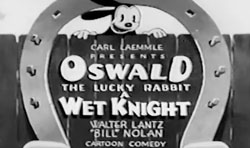 A Wet Knight (Lantz/Universal, Oswald the Lucky Rabbit, 6/20/32 – Walter Lantz/Bill Nolan, dir.) – Something is decidedly wrong about this film’s sound work. Currently-circulating print appears to be out of sync by approximately a one-second delay on sound – but any attempt to mentally retime effects with animation leads one to the conclusion that some sounds are also ahead of the mark, such that no amount of re-calibration of the placement of the track would seem to cure all ills. This thus may be one of the most poorly post-synched Oswalds ever released, with many problems built-in. We already know the sound is in trouble from shot 1, where Oswald appears to be serenading his lady love in a canoe – but no voice is emitted from his moving lips!
A Wet Knight (Lantz/Universal, Oswald the Lucky Rabbit, 6/20/32 – Walter Lantz/Bill Nolan, dir.) – Something is decidedly wrong about this film’s sound work. Currently-circulating print appears to be out of sync by approximately a one-second delay on sound – but any attempt to mentally retime effects with animation leads one to the conclusion that some sounds are also ahead of the mark, such that no amount of re-calibration of the placement of the track would seem to cure all ills. This thus may be one of the most poorly post-synched Oswalds ever released, with many problems built-in. We already know the sound is in trouble from shot 1, where Oswald appears to be serenading his lady love in a canoe – but no voice is emitted from his moving lips!
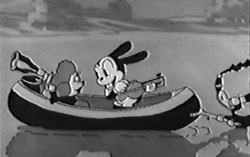 The film is an incredibly loose, non-stop amalgam of haunted house gags, seeming a twin to the more familiar public-domain episode, “Mechanical Man”, produced earlier the same season. The storm action as usual takes place at the beginning, as two black clouds collide in the sky above, re-forming into humanized shape, and engaging in a bout of street fighting, including one chomping like a dog upon the rear end of the other between blows. An odd-looking, confused sun looks on from above, with eyes that consist of electric light bulbs. The two angered clouds deliver random socks, perhaps intended for each other, or perhaps for their spectator. Whatever the target, each blow literally “knocks the light out” of the sun, breaking both bulbs. The sky thus darkens upon Oswald below, as the rains from the two opponents above begin to fall. Oswald paddles the canoe to reach the riverbank, but a duck in the water has more efficient ideas, producing an outboard motor to sail away. A jagged lightning bolt reaches down to saw the canoe in two, leaving Oswald and his girlfriend to cross a drawbridge to a lightning-illuminated castle. The drawbridge raises behind them, revealing a sign painted underneath, reading “Haunted Castle”. Oswald and the girl are seemingly locked in – but story continuity becomes unimportant, as a stray gorilla also traveling in the woods seemingly has no trouble entering the castle shortly thereafter despite the drawbridge being up. Before entering, the gorilla too is attacked by the storm. A lightning strike carves a jagged path of bared skin down his back, which the gorilla zips up like a zipper. Then, a rare instance in an animated cartoon of ball lightning strikes down, to be swallowed by the gorilla, and bounce around inside him as if he swallowed a basketball. Inside the castle, Oswald and the girl are experiencing chattering teeth and heart palpitations, as a trio of peg-legged pirate ghosts march by and through a wall, then a ghostly organist entertains in the manner of the phantom of the opera. Oswald reaches out to get the attention of the organist, but his hand goes right through the ectoplasm of the ghost’s back, the ghost failing to notice him. Oswald shows the phenomenon to his girl, then becomes playful, showing off as if he is beating up on the ghost, though his fists again go right through, leaving the ghost unharmed and undisturbed. Now the gorilla suddenly makes an appearance inside. The organist beats a hasty retreat, and the girl screams, but Oswald remains unphased. “Another ghost”, he claims, and delivers a sock into the ape’s face. Bad move.
The film is an incredibly loose, non-stop amalgam of haunted house gags, seeming a twin to the more familiar public-domain episode, “Mechanical Man”, produced earlier the same season. The storm action as usual takes place at the beginning, as two black clouds collide in the sky above, re-forming into humanized shape, and engaging in a bout of street fighting, including one chomping like a dog upon the rear end of the other between blows. An odd-looking, confused sun looks on from above, with eyes that consist of electric light bulbs. The two angered clouds deliver random socks, perhaps intended for each other, or perhaps for their spectator. Whatever the target, each blow literally “knocks the light out” of the sun, breaking both bulbs. The sky thus darkens upon Oswald below, as the rains from the two opponents above begin to fall. Oswald paddles the canoe to reach the riverbank, but a duck in the water has more efficient ideas, producing an outboard motor to sail away. A jagged lightning bolt reaches down to saw the canoe in two, leaving Oswald and his girlfriend to cross a drawbridge to a lightning-illuminated castle. The drawbridge raises behind them, revealing a sign painted underneath, reading “Haunted Castle”. Oswald and the girl are seemingly locked in – but story continuity becomes unimportant, as a stray gorilla also traveling in the woods seemingly has no trouble entering the castle shortly thereafter despite the drawbridge being up. Before entering, the gorilla too is attacked by the storm. A lightning strike carves a jagged path of bared skin down his back, which the gorilla zips up like a zipper. Then, a rare instance in an animated cartoon of ball lightning strikes down, to be swallowed by the gorilla, and bounce around inside him as if he swallowed a basketball. Inside the castle, Oswald and the girl are experiencing chattering teeth and heart palpitations, as a trio of peg-legged pirate ghosts march by and through a wall, then a ghostly organist entertains in the manner of the phantom of the opera. Oswald reaches out to get the attention of the organist, but his hand goes right through the ectoplasm of the ghost’s back, the ghost failing to notice him. Oswald shows the phenomenon to his girl, then becomes playful, showing off as if he is beating up on the ghost, though his fists again go right through, leaving the ghost unharmed and undisturbed. Now the gorilla suddenly makes an appearance inside. The organist beats a hasty retreat, and the girl screams, but Oswald remains unphased. “Another ghost”, he claims, and delivers a sock into the ape’s face. Bad move.
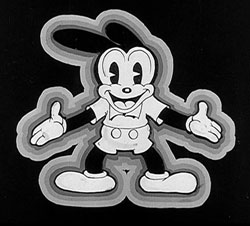 After several minutes of chasing, including an encounter with a fleeing skeleton, with which Oswald gets tangled up inside the bony one’s rib cage, Oswald becomes cornered in a dead-end corridor by the gorilla. Brave to the end, Oswald doesn’t take this lying fown, and grabs up a wood chip, placing it on his shoulder in a defant gesture to invite the ape to knock it off. The ape’s first response is to bat Oswald a sock that bounces him around the narrow corridor as if a good shot had just been made on a handball court. Oswald tries the chip again, and the gorilla flicks it away. A chain-reaction of events is set in motion, involving a row of statues. (Fred “Tex” Avery was involved on this cartoon, and one may wonder if this next sequence of gags was contributed by him.) The chip lands on one of the scales of “Justice”, tipping them. On the other scale happens to rest a live lobster, which is flipped over to a statue of Dan Cupid, taking a nip at his rear-end with its claws. Startled cupid fires an arrow, into the rear of Atlas, carrying the world. Atlas becomes smitten, breaks into an effeminate dance with the globe, then trots over to a statue of a Gladiator, affectionately tapping him on the shoulder and uttering the standard “gay” line, “Whoops!”. The gladiator responds by belting Atlas with a blow to the gut, knocking the globe out of his hands. The globe bounces into the belly of a miniature replica of the Statue of Liberty. She drops her torch, which falls upon the fuse of a cannon. The cannon races around, dragging its butt on the ground to try to put out the flame (a gag later stolen by Harman and Ising for their Cinecolor Merrie Melody, “Beauty and the Beast”), then the cannon fires, aimed backwards at the gorilla. The cannonball misses its mark, barely passing the gorilla, to ricochet off one of the castle walls. The gorilla gives it a raspberry, jeering it for the near-miss. The angered cannonball develops a face, brakes to a stop in mid-air, then reverses course to fly again at the gorilla. The ball again comes to a stop in flight just shy of the gorilla, develops a foot, and gives the gorilla’s rear a kick. The gorilla drops Oswald, turns, and socks the cannonball with a haymaker blow. The ball explodes – and all that is left of the gorilla is a huge skeleton, frozen in a perplexed pose which registers the thought, “What happened?” Oswald’s girl catches up to him, and Oswald claims the credit for the victory, receiving passionate kisses from the girl which knock him for a loop, for the fade out.
After several minutes of chasing, including an encounter with a fleeing skeleton, with which Oswald gets tangled up inside the bony one’s rib cage, Oswald becomes cornered in a dead-end corridor by the gorilla. Brave to the end, Oswald doesn’t take this lying fown, and grabs up a wood chip, placing it on his shoulder in a defant gesture to invite the ape to knock it off. The ape’s first response is to bat Oswald a sock that bounces him around the narrow corridor as if a good shot had just been made on a handball court. Oswald tries the chip again, and the gorilla flicks it away. A chain-reaction of events is set in motion, involving a row of statues. (Fred “Tex” Avery was involved on this cartoon, and one may wonder if this next sequence of gags was contributed by him.) The chip lands on one of the scales of “Justice”, tipping them. On the other scale happens to rest a live lobster, which is flipped over to a statue of Dan Cupid, taking a nip at his rear-end with its claws. Startled cupid fires an arrow, into the rear of Atlas, carrying the world. Atlas becomes smitten, breaks into an effeminate dance with the globe, then trots over to a statue of a Gladiator, affectionately tapping him on the shoulder and uttering the standard “gay” line, “Whoops!”. The gladiator responds by belting Atlas with a blow to the gut, knocking the globe out of his hands. The globe bounces into the belly of a miniature replica of the Statue of Liberty. She drops her torch, which falls upon the fuse of a cannon. The cannon races around, dragging its butt on the ground to try to put out the flame (a gag later stolen by Harman and Ising for their Cinecolor Merrie Melody, “Beauty and the Beast”), then the cannon fires, aimed backwards at the gorilla. The cannonball misses its mark, barely passing the gorilla, to ricochet off one of the castle walls. The gorilla gives it a raspberry, jeering it for the near-miss. The angered cannonball develops a face, brakes to a stop in mid-air, then reverses course to fly again at the gorilla. The ball again comes to a stop in flight just shy of the gorilla, develops a foot, and gives the gorilla’s rear a kick. The gorilla drops Oswald, turns, and socks the cannonball with a haymaker blow. The ball explodes – and all that is left of the gorilla is a huge skeleton, frozen in a perplexed pose which registers the thought, “What happened?” Oswald’s girl catches up to him, and Oswald claims the credit for the victory, receiving passionate kisses from the girl which knock him for a loop, for the fade out.
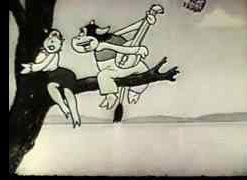 Spring is Here (Terrytoons/Educational, Farmer Al Falfa, 7/24/32 – Frank Moser, Paul Terry, dir.) – A furious storm blows across Farmer Al Falfa’s farm. It threatens the shingles of the roof, then dismantles the chimney brick by brick, exposing the stork that lives within to the elements. It seems as though everything that’s not nailed down is sailing in the fierce wind – including umbrellas, cows, long underwear, and ice boxes. An owl perched on a tree limb is sheared of all his feathers, left standing in polka-dotted pajamas. The wind finally gets hold of Al Falfa’s farmhouse, ripping it apart chunk by chunk, exposing the old geezer asleep in a brass bed. He is awakened when he is hit in the face with the long underwear. Then, his bed is carried aloft in the gale. Al looks around for some refuge, as his outhouse, also blown aloft, comes into view. With some difficulty, Al makes a leap from the bed to the outhouse, slamming the door behind him. But the minute he is inside, the winds diminish, leaving the out-building to tumble to the ground and crash. To our surprise, from out of the wreckage leaps the farmer, dressed in his underwear and a ballet tutu! In a falsetto voice, as the sun now beams down upon him, he flits around like a wood sprite, singing an effeminate ditty, “Hi yo ad Ha Ha Ha. Spring is here again!” As he completes his chorus, he receives reaction from his only audience – a tree – who abruptly pulls out a pistol and shoots him! So much for the storm action of this otherwise rambling epic, and so much for the farmer! The only other real highlight of the film is an original vocal, performed first by a cow, and later by a mouse, as they feel the effects of Cupid’s arrows – “I Give In To You”, performed humorously in a style poking fun at the crooning ditties of Bing Crosby.
Spring is Here (Terrytoons/Educational, Farmer Al Falfa, 7/24/32 – Frank Moser, Paul Terry, dir.) – A furious storm blows across Farmer Al Falfa’s farm. It threatens the shingles of the roof, then dismantles the chimney brick by brick, exposing the stork that lives within to the elements. It seems as though everything that’s not nailed down is sailing in the fierce wind – including umbrellas, cows, long underwear, and ice boxes. An owl perched on a tree limb is sheared of all his feathers, left standing in polka-dotted pajamas. The wind finally gets hold of Al Falfa’s farmhouse, ripping it apart chunk by chunk, exposing the old geezer asleep in a brass bed. He is awakened when he is hit in the face with the long underwear. Then, his bed is carried aloft in the gale. Al looks around for some refuge, as his outhouse, also blown aloft, comes into view. With some difficulty, Al makes a leap from the bed to the outhouse, slamming the door behind him. But the minute he is inside, the winds diminish, leaving the out-building to tumble to the ground and crash. To our surprise, from out of the wreckage leaps the farmer, dressed in his underwear and a ballet tutu! In a falsetto voice, as the sun now beams down upon him, he flits around like a wood sprite, singing an effeminate ditty, “Hi yo ad Ha Ha Ha. Spring is here again!” As he completes his chorus, he receives reaction from his only audience – a tree – who abruptly pulls out a pistol and shoots him! So much for the storm action of this otherwise rambling epic, and so much for the farmer! The only other real highlight of the film is an original vocal, performed first by a cow, and later by a mouse, as they feel the effects of Cupid’s arrows – “I Give In To You”, performed humorously in a style poking fun at the crooning ditties of Bing Crosby.
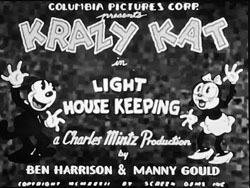 Lighthouse Keeping (Charles Mintz/Columbia, Krazy Kat, 8/15/32) – Perhaps one of the best paced, action-packed Krazys ever produced, with a solid story-structure that could reasonably compete with many Mickey Mouse films of the day. The scene opens at a lighthouse isolated on a rocky island along the coast. Though no storm is yet in progress, the waves in this region tend to be naturally abusive, intermittently delivering both socks and strangleholds upon the quite-flexible lighthouse with the sea’s white-capped hands. Inside, Krazy takes it in stride, keeping everything tidy with dusting – even dusting off the lit flame inside the lighthouse’s huge lamp. However, the flame dwindles and goes out, the trails of its dissipating smoke tying themselves into a bowknot. Krazy’s low on fuel. But the timing is right, as Krazy’s fuel delivery is just arriving – via a small fish, riding inside the blowhole of a large whale. The blowhole flips open wider, to reveal a gasoline-style fuel pumper, connected to a long hose which is raised to Krazy’s window. Krazy hooks the hose to the lamp, and receives his weekly supply of fresh whale oil, straight from the source. Krazy engages in some brief celebratory dancing and musicale with a seal and several fish, utilizing some interesting camera techniques, including two backgrounds painted in the round, rotated 360 degrees in partial view, to allow Krazy to dance completely around both the interior and exterior of the ground floor of the lighthouse. (I wonder what kind of special camera mount they used to accommodate these backgrounds, while still keeping the rectangular cels in register?)
Lighthouse Keeping (Charles Mintz/Columbia, Krazy Kat, 8/15/32) – Perhaps one of the best paced, action-packed Krazys ever produced, with a solid story-structure that could reasonably compete with many Mickey Mouse films of the day. The scene opens at a lighthouse isolated on a rocky island along the coast. Though no storm is yet in progress, the waves in this region tend to be naturally abusive, intermittently delivering both socks and strangleholds upon the quite-flexible lighthouse with the sea’s white-capped hands. Inside, Krazy takes it in stride, keeping everything tidy with dusting – even dusting off the lit flame inside the lighthouse’s huge lamp. However, the flame dwindles and goes out, the trails of its dissipating smoke tying themselves into a bowknot. Krazy’s low on fuel. But the timing is right, as Krazy’s fuel delivery is just arriving – via a small fish, riding inside the blowhole of a large whale. The blowhole flips open wider, to reveal a gasoline-style fuel pumper, connected to a long hose which is raised to Krazy’s window. Krazy hooks the hose to the lamp, and receives his weekly supply of fresh whale oil, straight from the source. Krazy engages in some brief celebratory dancing and musicale with a seal and several fish, utilizing some interesting camera techniques, including two backgrounds painted in the round, rotated 360 degrees in partial view, to allow Krazy to dance completely around both the interior and exterior of the ground floor of the lighthouse. (I wonder what kind of special camera mount they used to accommodate these backgrounds, while still keeping the rectangular cels in register?)
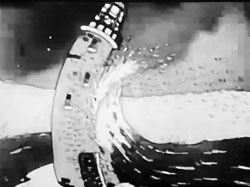 Krazy hears a boat whistle, and climbs back into the tower, looking out to sea through a spyglass. He spots a single-stacked steamer hopping over the waves, briefly clearing the “throat” of its smokestack by belching out a flock of birds which was nesting inside. On the pitching deck is Kitty, playing a concertina to the melody of “A Life On the Ocean Waves”. Krazy blows her a handful of kisses, but has his attention suddenly drawn away to developments above. Black clouds have appeared, with a lower section which resembles a dirigible gondola. Hatchways open in the “gondola” where windows should be, each hatch containing a huge watering can, which pours out a goodly dose of rain. The sun is cornered between several cloudbanks of like type, and covered over, as a lightning bolt saws away the bottom half of the clouds, unleashing their liquid contents. The lighthouse begins to take a beating, bending and swaying in the gusts of heavy wind. Below, the whitecaps have formed into the shape of the head of a chomping alligator or serpent, which tries its best to take a bite out of the side of the tower. Krazy reflexively dodges right and left inside his glassy perch as lightning bolts strike quite closely on either side. Suddenly, a strange phenomenon occurs, as a flock of sea birds circle the tower, one of them pausing to peck a knock upon one of Krazy’s windows. Krazy responds, descending to a smaller window in the face of a lower floor of the tower, sealed from the elements by a shutter. Krazy opens the shutter, permitting one of the birds to enter. We find that Krazy runs a laundry service on the side for just such occasions, as each bird enters, to have his feathered “coat” removed and run through a laundry wringer to squeeze it dry. As the last bird leaves satisfied, Krazy is greeted at the window by a wave full of fish tossed up by the increasingly-violent waves from below. He grabs up his spyglass again to check on the status of the ship. The sea is literally playing catch with the vessel, as one wavy hand tosses the ship like a plaything to another hand, and yet another. In the radio room, Kitty uses her own version of a telegraph to send out an S.O.S. – by tapping on the fastened tail of a long-tailed mouse, whose mouth squeaks out the signal.
Krazy hears a boat whistle, and climbs back into the tower, looking out to sea through a spyglass. He spots a single-stacked steamer hopping over the waves, briefly clearing the “throat” of its smokestack by belching out a flock of birds which was nesting inside. On the pitching deck is Kitty, playing a concertina to the melody of “A Life On the Ocean Waves”. Krazy blows her a handful of kisses, but has his attention suddenly drawn away to developments above. Black clouds have appeared, with a lower section which resembles a dirigible gondola. Hatchways open in the “gondola” where windows should be, each hatch containing a huge watering can, which pours out a goodly dose of rain. The sun is cornered between several cloudbanks of like type, and covered over, as a lightning bolt saws away the bottom half of the clouds, unleashing their liquid contents. The lighthouse begins to take a beating, bending and swaying in the gusts of heavy wind. Below, the whitecaps have formed into the shape of the head of a chomping alligator or serpent, which tries its best to take a bite out of the side of the tower. Krazy reflexively dodges right and left inside his glassy perch as lightning bolts strike quite closely on either side. Suddenly, a strange phenomenon occurs, as a flock of sea birds circle the tower, one of them pausing to peck a knock upon one of Krazy’s windows. Krazy responds, descending to a smaller window in the face of a lower floor of the tower, sealed from the elements by a shutter. Krazy opens the shutter, permitting one of the birds to enter. We find that Krazy runs a laundry service on the side for just such occasions, as each bird enters, to have his feathered “coat” removed and run through a laundry wringer to squeeze it dry. As the last bird leaves satisfied, Krazy is greeted at the window by a wave full of fish tossed up by the increasingly-violent waves from below. He grabs up his spyglass again to check on the status of the ship. The sea is literally playing catch with the vessel, as one wavy hand tosses the ship like a plaything to another hand, and yet another. In the radio room, Kitty uses her own version of a telegraph to send out an S.O.S. – by tapping on the fastened tail of a long-tailed mouse, whose mouth squeaks out the signal.
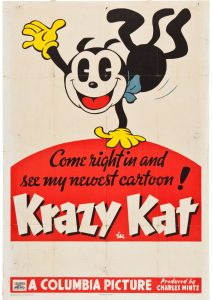 Lightning strikes the ship’s bow sideways, drilling a large hole from one side of the ship to the other. Below decks, the rats are deserting a sinking ship – and taking a large wheel of Swiss cheese with them. Kitty screams for help from the deck. Krazy launches a longboat, fighting against the tide, which compresses the craft like an accordion, and intermittently forces crazy to pump his oars like wings to stay above the waves. Meanwhile, the sea shows no mercy for Kitty’s craft, its white caps opening like a huge mouth to swallow the ship whole, then spit Kitty out into the foam. Kitty finds a stray wooden door from the wreckage to ride on, and runs her panties up one upraised leg as a distress signal. Krazy continues to have trouble with the current, losing one of his oars, but resiliently begins rotating the other oar in his hand like a drum major, converting it into a bow propeller, which allows him to cut a hole right through the oncoming waves. A sudden, unexpected finish occurs, as Krazy’s boat collides with Kitty’s raft, causing each vessel to go under. Krazy, clutching Kitty, grabs for the nearest thing he can see – a floating bell buoy. However, this is not merely a buoy, as it rises out of the ocean. The bell is mounted atop the back of a whale, whose body appears to have been hollowed out as a passenger car, complete with doors and windows. An old bearded man emerges from the helm of this odd conveyance, opens the door, and graciously invites Krazy and Kitty to enter. They get inside, and the old man rings the bell twice, and sets the whale into forward motion. The angle of the whale shifts in view, revealing a railroad car-style observation platform where his tail should be, on which Krazy and Kitty stand enjoying the view on a now placid sea, while a sign on the railing identifies the craft as the “Jonah Limited”. Krazy and Kitty wave goodbye ro the audience and exchange kisses, while the wake of the whale’s trail leaves an impression in the foam of the waves below resembling train tracks, and the whale disappears into the distance.
Lightning strikes the ship’s bow sideways, drilling a large hole from one side of the ship to the other. Below decks, the rats are deserting a sinking ship – and taking a large wheel of Swiss cheese with them. Kitty screams for help from the deck. Krazy launches a longboat, fighting against the tide, which compresses the craft like an accordion, and intermittently forces crazy to pump his oars like wings to stay above the waves. Meanwhile, the sea shows no mercy for Kitty’s craft, its white caps opening like a huge mouth to swallow the ship whole, then spit Kitty out into the foam. Kitty finds a stray wooden door from the wreckage to ride on, and runs her panties up one upraised leg as a distress signal. Krazy continues to have trouble with the current, losing one of his oars, but resiliently begins rotating the other oar in his hand like a drum major, converting it into a bow propeller, which allows him to cut a hole right through the oncoming waves. A sudden, unexpected finish occurs, as Krazy’s boat collides with Kitty’s raft, causing each vessel to go under. Krazy, clutching Kitty, grabs for the nearest thing he can see – a floating bell buoy. However, this is not merely a buoy, as it rises out of the ocean. The bell is mounted atop the back of a whale, whose body appears to have been hollowed out as a passenger car, complete with doors and windows. An old bearded man emerges from the helm of this odd conveyance, opens the door, and graciously invites Krazy and Kitty to enter. They get inside, and the old man rings the bell twice, and sets the whale into forward motion. The angle of the whale shifts in view, revealing a railroad car-style observation platform where his tail should be, on which Krazy and Kitty stand enjoying the view on a now placid sea, while a sign on the railing identifies the craft as the “Jonah Limited”. Krazy and Kitty wave goodbye ro the audience and exchange kisses, while the wake of the whale’s trail leaves an impression in the foam of the waves below resembling train tracks, and the whale disappears into the distance.
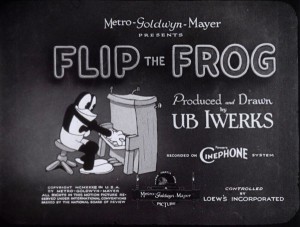 Stormy Seas (Iwerks/MGM, Flip the Frog, 8/22/32) – Flip is part of a four-man crew aboard a one-masted vessel which combines both steam power and a square sail. There is no particular indication who is captain, as the sailors take turns at the helm, and interchange places plating hornpipes on a small concertina. Flip’s turn at playing the instrument gives out a sour note – resulting from finding a live skunk stowed away inside the bellows. Flip tosses the creature into the ocean, causing all the local fish to rise from the water, hold their noses, and head for the open seas. On flip’s arm is revealed a tattoo of a dancing hula maiden, who not only sways seductively to the music, but turns her back to Flip, shimmying her posterior a bit too provocatively, causing Flip to discipline her by spanking her rear. Suddenly, a large gray cloud gathers close to the waterline, forming a bulb-nosed, puffy but menacing face. It blows with increasing force upon the water, stirring up the current. The face laughs, its tongue emerging in the form of a lightning bolt. Its lips suck up a goodly supply of sea water, then it spits the water out in a continuing stream between its teeth as rain. A parrot in the ship’s crow’s nest calls down to Flip, warning him of the impending blow. The ship begins to bob and pitch above tremendous waves, in a well-animated special -effects shot, where waves crash down at the ship from either side, causing it to dodge streams of water that look like long thin fingers attempting to reach out and grab it. The parrot trues to hang onto the crow’s nest railing, but the wind’s force shears away all of its feathers, causing the bird to blush and duck down deep behind the rail to get out of sight. Flip spins upon the ship’s wheel in similar fashion to Bosko last week, then is thrown off the deck into the ship’s cabin. A large radio receiver is within, its meters and dials forming a face, as the set emits the beeps of an S.O.S. distress call. Flip sits in a daze in the center of the cabin, and the radio set is forced to extend one of its dials as a hand, to tap Flip on the shoulder, then point attention to itself for Flip to take the headphones and receive the call. Upon realizing that someone is in peril, Flip grabs a spyglass, and looks out to sea from the bow. There, through a troth between rows of crashing waves on either side, Flip spots another vessel with tattered sail adrift directly across his own ship’s path. A flare goes up from the ship, forming into the letters “S.O.S.” Aboard, a cat maiden stands at the bow, enduring choking gulps of water as her ship cuts straight through tall waves, and crying out for help.
Stormy Seas (Iwerks/MGM, Flip the Frog, 8/22/32) – Flip is part of a four-man crew aboard a one-masted vessel which combines both steam power and a square sail. There is no particular indication who is captain, as the sailors take turns at the helm, and interchange places plating hornpipes on a small concertina. Flip’s turn at playing the instrument gives out a sour note – resulting from finding a live skunk stowed away inside the bellows. Flip tosses the creature into the ocean, causing all the local fish to rise from the water, hold their noses, and head for the open seas. On flip’s arm is revealed a tattoo of a dancing hula maiden, who not only sways seductively to the music, but turns her back to Flip, shimmying her posterior a bit too provocatively, causing Flip to discipline her by spanking her rear. Suddenly, a large gray cloud gathers close to the waterline, forming a bulb-nosed, puffy but menacing face. It blows with increasing force upon the water, stirring up the current. The face laughs, its tongue emerging in the form of a lightning bolt. Its lips suck up a goodly supply of sea water, then it spits the water out in a continuing stream between its teeth as rain. A parrot in the ship’s crow’s nest calls down to Flip, warning him of the impending blow. The ship begins to bob and pitch above tremendous waves, in a well-animated special -effects shot, where waves crash down at the ship from either side, causing it to dodge streams of water that look like long thin fingers attempting to reach out and grab it. The parrot trues to hang onto the crow’s nest railing, but the wind’s force shears away all of its feathers, causing the bird to blush and duck down deep behind the rail to get out of sight. Flip spins upon the ship’s wheel in similar fashion to Bosko last week, then is thrown off the deck into the ship’s cabin. A large radio receiver is within, its meters and dials forming a face, as the set emits the beeps of an S.O.S. distress call. Flip sits in a daze in the center of the cabin, and the radio set is forced to extend one of its dials as a hand, to tap Flip on the shoulder, then point attention to itself for Flip to take the headphones and receive the call. Upon realizing that someone is in peril, Flip grabs a spyglass, and looks out to sea from the bow. There, through a troth between rows of crashing waves on either side, Flip spots another vessel with tattered sail adrift directly across his own ship’s path. A flare goes up from the ship, forming into the letters “S.O.S.” Aboard, a cat maiden stands at the bow, enduring choking gulps of water as her ship cuts straight through tall waves, and crying out for help.
 Flip attempts to throw a life preserver in the helpless ship’s direction. But the wind redirects the ring, curving it in a loop back like a boomerang, and conking Flip with it. Flip tries a second method to pitch the preserver to the distressed ship – by tying its rope around a cannon ball, then loading the ball into the muzzle of the cannon on the forward deck. Unfortunately, Flip just can’t seem to get right how much powder to use. The first shot merely drops the ball with a plop out of the muzzle, back on deck. The second shot overdoes it, blasting the cannon backwards out of frame from the recoil, but leaving the ball exactly where it was when it started. Flip gives up on the preserver, and instead ties the rope around his own waist. He stands on the railing, attempting to jump into the sea – but the ship pitches from side to side so hard, the deck merely moves directly under the path of Flip’s jump, landing him back on the ship. Only when Flip is merely trying to regain his footing does another pitch land him plunk within the ocean water. Flip cuts through the caps of oncoming waves, then is pitched by the last one onto the deck of the second vessel. The purpose of the rope previously fastened to him is lost to the animators, who suddenly depict the rope unknotted from Flip’s person, and never have Flip take hold of it again. Flip instead signals the cat to accompany him to the side, and the lifeboat davits. (Why didn’t the cat think of lowering the lifeboat herself?) A clever scene has the lifeboat putting up every bit of defiance imaginable to being lowered toward the water. First, as Flip and the cat manipulate the ropes from the davits, the walls of the ship lower to sea level, while the deck and seats carrying Flip and the cat remain motionless at deck level above. Flip and the cat haul in the ropes, raising the boat’s walls back to a position where Flip attempts to reconnect them with the boat’s decking. The ropes are lowered again, but this time Flip and the cat descend with the decking, leaving the boat’s walls high above them. Another haul-in on the lines brings both halves of the boat back together, and Flip finally grabs a length of rope and lashes it around the boat’s middle, to make sure both deck and walls will stay together for the third descent to the sea. However, we find the cat was not entirely alone aboard the ship. A fat cat in a top hat emerges from below decks, carrying a suitcase of his belongings, and hollers to wait for him.
Flip attempts to throw a life preserver in the helpless ship’s direction. But the wind redirects the ring, curving it in a loop back like a boomerang, and conking Flip with it. Flip tries a second method to pitch the preserver to the distressed ship – by tying its rope around a cannon ball, then loading the ball into the muzzle of the cannon on the forward deck. Unfortunately, Flip just can’t seem to get right how much powder to use. The first shot merely drops the ball with a plop out of the muzzle, back on deck. The second shot overdoes it, blasting the cannon backwards out of frame from the recoil, but leaving the ball exactly where it was when it started. Flip gives up on the preserver, and instead ties the rope around his own waist. He stands on the railing, attempting to jump into the sea – but the ship pitches from side to side so hard, the deck merely moves directly under the path of Flip’s jump, landing him back on the ship. Only when Flip is merely trying to regain his footing does another pitch land him plunk within the ocean water. Flip cuts through the caps of oncoming waves, then is pitched by the last one onto the deck of the second vessel. The purpose of the rope previously fastened to him is lost to the animators, who suddenly depict the rope unknotted from Flip’s person, and never have Flip take hold of it again. Flip instead signals the cat to accompany him to the side, and the lifeboat davits. (Why didn’t the cat think of lowering the lifeboat herself?) A clever scene has the lifeboat putting up every bit of defiance imaginable to being lowered toward the water. First, as Flip and the cat manipulate the ropes from the davits, the walls of the ship lower to sea level, while the deck and seats carrying Flip and the cat remain motionless at deck level above. Flip and the cat haul in the ropes, raising the boat’s walls back to a position where Flip attempts to reconnect them with the boat’s decking. The ropes are lowered again, but this time Flip and the cat descend with the decking, leaving the boat’s walls high above them. Another haul-in on the lines brings both halves of the boat back together, and Flip finally grabs a length of rope and lashes it around the boat’s middle, to make sure both deck and walls will stay together for the third descent to the sea. However, we find the cat was not entirely alone aboard the ship. A fat cat in a top hat emerges from below decks, carrying a suitcase of his belongings, and hollers to wait for him.
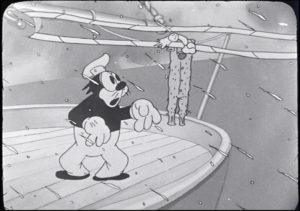 Flip attempts to position the lifeboat to receive him – but the violent sea keeps dropping out from under the boat at the crucial moment, putting about ten feet of distance between the fat cat and the boat each time he prepares to jump in. The cat passenger finally takes a plunge at the boat below, landing in it with such force, he jettisons Flip and the female cat back onto the deck of the ship above. Having no concern for the plight of the others, the fat cat selfishly mans the oars, and rows away, leaving Flip and the girl to their fate. Flip looks around, realizing there are no other lifeboats. He gets an idea, and hails another member of the crew aboard his own ship, then tosses toward the crew member both ends of a long coil of rope, leaving the middle section of the rope looped around a pole. Aboard Flip’s ship, the crew member grabs both trailing ends of the rope, threads them through a pulley, and ties the rope ends together, forming a breeches buoy line. The crew member then orders a pair of long johns hanging on a clothesline to assume position upon the buoy line. The underwear is tugged by the buoy rope over to the vessel in distress, and Flip and the cat jump into the underwear drop seat, to take the ride back to safety. The sailors on Flip’s ship begin to haul in the buoy line. Who should rise at this crucial moment from the sea, but the transparent giant form of King Neptune, spying the powerless vessel Flip is just leaving. Neptune decides to claim it for his own, and grabs hold of the bow of the ship, dragging it underwater. A face develops on the underside of the stern hull, screaming for help just before the ship disappears below the waves. The tow line of the breeches buoy suddenly sags, and Flip and the cat are pulled underwater as well. Flip tugs and tugs at the rope to fight against Neptune’s pull, but to no avail. Fortunately for him, a swordfish floats by. Flip socks the swordfish in the eye, knocking him out, then uses his saw to cut the rope tethering then to the sunken ship. The crew on Flip’s ship quickly hauls in the other end of the rope, raising Flip and the cat to safety. The cat rewards Flip with a kiss, as the crew look on and cheer. Flip prefers a little privacy, and buttons the drop seat of the underwear to hide the further view of the cat bestowing her affections upon him, while small hearts emerge from the seams of the drop seat to indicate the wooing continuing within, for the iris out.
Flip attempts to position the lifeboat to receive him – but the violent sea keeps dropping out from under the boat at the crucial moment, putting about ten feet of distance between the fat cat and the boat each time he prepares to jump in. The cat passenger finally takes a plunge at the boat below, landing in it with such force, he jettisons Flip and the female cat back onto the deck of the ship above. Having no concern for the plight of the others, the fat cat selfishly mans the oars, and rows away, leaving Flip and the girl to their fate. Flip looks around, realizing there are no other lifeboats. He gets an idea, and hails another member of the crew aboard his own ship, then tosses toward the crew member both ends of a long coil of rope, leaving the middle section of the rope looped around a pole. Aboard Flip’s ship, the crew member grabs both trailing ends of the rope, threads them through a pulley, and ties the rope ends together, forming a breeches buoy line. The crew member then orders a pair of long johns hanging on a clothesline to assume position upon the buoy line. The underwear is tugged by the buoy rope over to the vessel in distress, and Flip and the cat jump into the underwear drop seat, to take the ride back to safety. The sailors on Flip’s ship begin to haul in the buoy line. Who should rise at this crucial moment from the sea, but the transparent giant form of King Neptune, spying the powerless vessel Flip is just leaving. Neptune decides to claim it for his own, and grabs hold of the bow of the ship, dragging it underwater. A face develops on the underside of the stern hull, screaming for help just before the ship disappears below the waves. The tow line of the breeches buoy suddenly sags, and Flip and the cat are pulled underwater as well. Flip tugs and tugs at the rope to fight against Neptune’s pull, but to no avail. Fortunately for him, a swordfish floats by. Flip socks the swordfish in the eye, knocking him out, then uses his saw to cut the rope tethering then to the sunken ship. The crew on Flip’s ship quickly hauls in the other end of the rope, raising Flip and the cat to safety. The cat rewards Flip with a kiss, as the crew look on and cheer. Flip prefers a little privacy, and buttons the drop seat of the underwear to hide the further view of the cat bestowing her affections upon him, while small hearts emerge from the seams of the drop seat to indicate the wooing continuing within, for the iris out.
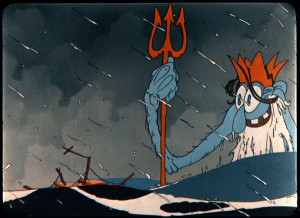 Fast-forwarding a few years for a brief detour, it is notable at this point that Iwerks’ second use of the new Cinecolor process, Willie Whopper’s Davey Jones’ Locker (MGM, 1/13/34), is partially a cheater. Nearly all storm scenes in the film are lifted verbatim from the animation in Flip’s “Stormy Seas”, though colored-in for more dazzling effect. It repeats the cloud-face sucking in water and spitting rain, the finger-waves that try to swamp the ship, and the appearance of the giant Neptune to drag the ship under. Curiously, this reuse of animation leads to a direct contradiction between new and old shots. Neptune is first seen here on a throne on the ocean floor, with Willie’s fishing line snagging-off his crown. The crown is brought up upon the line, and is of appropriate size for Willie to present it as a gift to his girlfriend, who models it atop her own head. Everyone seems to forget that the old animation shows Neptune about a hundred feet tall, and still wearing his crown, in a hat size that would be so large, it would have sunk the ship by itself! No explanation is offered as to how Neptune grew, nor as to how he got his royal headgear back. The remainder of the film takes place entirely under the sea, thus having no further relevance to the present trail, as Willie visits the sunken ship lair of drunken pirate Davy Jones, first serenading him on piano with a mermaid trio jazzing up “Fifteen Men on a Dead Man’s Chest”, then engaging in a swordfight with Davy when the rum-soaked reprobate tries to make off with his gal.
Fast-forwarding a few years for a brief detour, it is notable at this point that Iwerks’ second use of the new Cinecolor process, Willie Whopper’s Davey Jones’ Locker (MGM, 1/13/34), is partially a cheater. Nearly all storm scenes in the film are lifted verbatim from the animation in Flip’s “Stormy Seas”, though colored-in for more dazzling effect. It repeats the cloud-face sucking in water and spitting rain, the finger-waves that try to swamp the ship, and the appearance of the giant Neptune to drag the ship under. Curiously, this reuse of animation leads to a direct contradiction between new and old shots. Neptune is first seen here on a throne on the ocean floor, with Willie’s fishing line snagging-off his crown. The crown is brought up upon the line, and is of appropriate size for Willie to present it as a gift to his girlfriend, who models it atop her own head. Everyone seems to forget that the old animation shows Neptune about a hundred feet tall, and still wearing his crown, in a hat size that would be so large, it would have sunk the ship by itself! No explanation is offered as to how Neptune grew, nor as to how he got his royal headgear back. The remainder of the film takes place entirely under the sea, thus having no further relevance to the present trail, as Willie visits the sunken ship lair of drunken pirate Davy Jones, first serenading him on piano with a mermaid trio jazzing up “Fifteen Men on a Dead Man’s Chest”, then engaging in a swordfight with Davy when the rum-soaked reprobate tries to make off with his gal.
 Back in chronological sequence, we close with King Neptune (Disney/United Artists, Silly Symphony, 9/10/32 – Burt Gillett, dir.). I have always found something a little unsettling about this cartoon, wondering whether there was some degree of cross-pollenation among the talent who produced it between Disney and Iwerks studios. For one thing, though its character design of Neptune is in many respects different than that used by Iwerks in “Stormy Seas”, his relative size to the ship above and the posing of his appearance on the surface to drive the ship under is remarkably similar between the two films, and evokes nearly the identical dramatic effect. What is more jarring is the pirate crew, who are drawn with a heavier, cruder line than is typical for a Disney product, and seem like they could have walked out of the frames of a later Iwerks Cinecolor effort, “Sinbad the Sailor”. True, Iwerks may merely have plagiarized the Disney models for his own pirates. But the resemblance is so close, it seems more possibly the result of the same pens drawing, rather than another artist’s mere attempt at a copy. Considering other instances in the 30’s when Disney and Iwerks studios produced concurrent product too similar to seem mere coincidence (identical goggle windshield-wiper gags in “The Mail Pilor” and “Spite Flight”, and concurrent productions based on “The Little Red Hen”), was there someone in common sharing the pirate designs between the two studios? This one may not fall under the heading of industrial espionage, but still might denote the hiring away of the same talent by one studio or another.
Back in chronological sequence, we close with King Neptune (Disney/United Artists, Silly Symphony, 9/10/32 – Burt Gillett, dir.). I have always found something a little unsettling about this cartoon, wondering whether there was some degree of cross-pollenation among the talent who produced it between Disney and Iwerks studios. For one thing, though its character design of Neptune is in many respects different than that used by Iwerks in “Stormy Seas”, his relative size to the ship above and the posing of his appearance on the surface to drive the ship under is remarkably similar between the two films, and evokes nearly the identical dramatic effect. What is more jarring is the pirate crew, who are drawn with a heavier, cruder line than is typical for a Disney product, and seem like they could have walked out of the frames of a later Iwerks Cinecolor effort, “Sinbad the Sailor”. True, Iwerks may merely have plagiarized the Disney models for his own pirates. But the resemblance is so close, it seems more possibly the result of the same pens drawing, rather than another artist’s mere attempt at a copy. Considering other instances in the 30’s when Disney and Iwerks studios produced concurrent product too similar to seem mere coincidence (identical goggle windshield-wiper gags in “The Mail Pilor” and “Spite Flight”, and concurrent productions based on “The Little Red Hen”), was there someone in common sharing the pirate designs between the two studios? This one may not fall under the heading of industrial espionage, but still might denote the hiring away of the same talent by one studio or another.
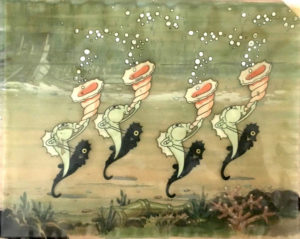 Neptune presides over his happy undersea court, inhabited by all manner of sea creatures, and a host of au natural mermaids, foregoing the clamshell bras of Ariel. All is well until a pirate crew encounters the mermaids sunning themselves on a rock. They drop anchor – right on top of Neptune, temporarily tangling him up in the anchor chain. They then kidnap one of the mermaids, apparently intent on taking advantage of her. She bravely fends off their attacks on deck, but is thrown into a treasure chest for safe-keeping. The sea creatures mount a massed attack to free the captive. Swordfish are shot in a row out of a whale’s mouth like machine gun fire, their noses sawing down the ship’s mainmast. Aerial assaults are coordinated between octopuses using their arms as helicopter blades and laden with fish bloated with a cargo of cannonballs from sunken ships, and flying fish who launch themselves from flat-top whales, carrying lobsters to drop on the ship’s deck and snap at the crew. Further mayhem results when an octopus tosses the pirate captain overboard, puts on his hat, and grabs up eight arms full of railing posts to bash on the heads of helpless crew members. The pirates are kept at bay long enough for Neptune to escape the chains, and make an appearance on the surface. With sadistic delight, Neptune holds the ship on the end of his trident. But rather than take it immediately as a prize, Neptune toys with it. He tosses it off his trident back into the sea, the impact knocking many pirates overboard. Those that are left begin firing the cannons at Neptune, but the tiny cannonballs merely bounce off him like peppercorns. Neptune laughs with fiendish glee, as he swirls the end of his trident in the water, producing a massive storm and giant whirlpools to spin the ship, blowing the pools into position with his own breath. The waves also form into socking hands, quite similar to those in Fleischer’s “Swim or Sink”. Finally, Neptune jumps from the sea in a flying leap, coming to rest seated atop the ship, riding it down into the depths, where it assumes the position of a new throne chair. From the sea chest emerges the trapped mermaid, now bedecked in a treasure of jewels. She shares with the rest of her kind, and all the mermaids soon glisten with the dazzling jewelry. Neptune sings a closing coda, oblivious to a fish who is almost swallowed within his open mouth as he sings his final long note.
Neptune presides over his happy undersea court, inhabited by all manner of sea creatures, and a host of au natural mermaids, foregoing the clamshell bras of Ariel. All is well until a pirate crew encounters the mermaids sunning themselves on a rock. They drop anchor – right on top of Neptune, temporarily tangling him up in the anchor chain. They then kidnap one of the mermaids, apparently intent on taking advantage of her. She bravely fends off their attacks on deck, but is thrown into a treasure chest for safe-keeping. The sea creatures mount a massed attack to free the captive. Swordfish are shot in a row out of a whale’s mouth like machine gun fire, their noses sawing down the ship’s mainmast. Aerial assaults are coordinated between octopuses using their arms as helicopter blades and laden with fish bloated with a cargo of cannonballs from sunken ships, and flying fish who launch themselves from flat-top whales, carrying lobsters to drop on the ship’s deck and snap at the crew. Further mayhem results when an octopus tosses the pirate captain overboard, puts on his hat, and grabs up eight arms full of railing posts to bash on the heads of helpless crew members. The pirates are kept at bay long enough for Neptune to escape the chains, and make an appearance on the surface. With sadistic delight, Neptune holds the ship on the end of his trident. But rather than take it immediately as a prize, Neptune toys with it. He tosses it off his trident back into the sea, the impact knocking many pirates overboard. Those that are left begin firing the cannons at Neptune, but the tiny cannonballs merely bounce off him like peppercorns. Neptune laughs with fiendish glee, as he swirls the end of his trident in the water, producing a massive storm and giant whirlpools to spin the ship, blowing the pools into position with his own breath. The waves also form into socking hands, quite similar to those in Fleischer’s “Swim or Sink”. Finally, Neptune jumps from the sea in a flying leap, coming to rest seated atop the ship, riding it down into the depths, where it assumes the position of a new throne chair. From the sea chest emerges the trapped mermaid, now bedecked in a treasure of jewels. She shares with the rest of her kind, and all the mermaids soon glisten with the dazzling jewelry. Neptune sings a closing coda, oblivious to a fish who is almost swallowed within his open mouth as he sings his final long note.
More 30‘s seasons of inclement weather, next time.


 Charles Gardner is an animation enthusiast who toils by day as a member of LA Law – but by nights and weekends indulges in classic jazz and ragtime as a performer; and studies classic Hollywood cartoons… maybe a little too much.
Charles Gardner is an animation enthusiast who toils by day as a member of LA Law – but by nights and weekends indulges in classic jazz and ragtime as a performer; and studies classic Hollywood cartoons… maybe a little too much.


































































































































































To my mind, the most remarkable example of congruence between the Disney and Iwerks studios in the 1930s is the very first one: Iwerks’s first cartoon made independently of Disney, “Fiddlesticks”, and Disney’s first cartoon made without Iwerks, “Fiddling Around” (both 1930), both revolve around a mouse playing a violin recital, and little else.
I agree that “King Neptune” is somewhat unsettling, largely owing to the graphic violence and nudity with which one does not normally associate Disney entertainment. In spite of this, or perhaps because of it, I quite like the cartoon; as far as I’m concerned, Disney’s second Technicolor Silly Symphony is a far cut above “Flowers and Trees”. Friedrich Silcher’s musical setting of Heinrich Heine’s poem “Die Lorelei” functions as a leitmotif for the topless mermaids, as it had in the Terrytoon “The Lorelei” a year earlier.
The prize this week goes to “Lighthouse Keeping”, a terrifically animated cartoon that I’ve never seen before. This is early ’30s anything-goes, anything-can-happen rubber-hoseyness at its finest. Composer Joe de Nat deserves special commendation for incorporating nearly all of Schubert’s “Der Erlkoenig” into his score, cleverly tailoring the orchestration to fit the action of the cartoon. Bravo!
No bravos for Oswald this week, though. Go hang your sheets out to dry, “Wet Knight”.
About Iwerks reusing gags from Disney, it’s likely that Iwerks himself came up with some of these gags and felt entitled to reused them in his cartoons. Stormy Seas even reuses a gag from Steamboat Willie, the boat whistle prodding the smaller whistle to finish the tune.
The goofy looking fish with the big nose that kept appearing in Davy Jones’ Locker seems like an early version of a gag that Tex Avery used a lot of in his early Looney Tunes, where an odd-looking character kept popping up during the film and was eventually revealed to be the hero. Egghead started out as one of those, and eventually became Elmer Fudd. Avery also used Droopy this way in a few of his MGM cartoons, like Wild and Wolfy
“The Ugly Duckling” (Walt Disney, Silly Symphonies, 16/12/31 — Wilfred Jackson, dir.) has been rejected by his foster family of chickens when a cyclone strikes the farm, stripping a shaggy dog of its fur and tying a cow’s legs into knots. Mother hen and the chicks take shelter in a chicken coop but slam its door in the face of the duckling, who digs a shelter for himself beneath it. Smart move, as the twister picks up the coop and takes it spinning through the air. The mother hen falls out of it and onto the ground; but the cyclone deposits the coop, chicks and all, onto a flood-swollen river, where it floats downstream until its gets caught on a branch at the edge of a waterfall. The duckling swims to the rescue and gets the chicks to climb aboard a pair of bellows among the detritus of the storm; then, jumping up and down on the bellows’ handles, the duckling uses jet propulsion to ferry the chicks to safety.
The music is provided by a duly silly but less than symphonic ensemble consisting of just flute, clarinet, piano, string quintet, and one percussionist. Bert Lewis’s rather unimaginative score is predictably based on the bucolic “By Heck” and the “Storm” section of the William Tell Overture. Lewis had some big shoes to fill after Carl Stalling left Disney for the Ub Iwerks studio, and for the most part he did a serviceable job; but the man was no Carl Stalling, much less an Albert Hay Malotte, and not even a Joe de Nat.
No such extreme weather everts occur in Disney’s 1939 “Ugly Duckling” remake.
That’s not the real title card for Light House Keeping. Here’s a copy with the real original titles (!), which match the credits in the copyright catalog listing, crediting Ben Harrison as the sole director and giving Preston Blair what’s potentially his first screen credit anywhere (?) alongside Al Eugster’s first Mintz screen credit:
https://www.youtube.com/watch?v=rnC74SvUPGA
As with the other three cartoons (Piano Mover, The Birth of Jazz, and The Paper Hanger) that Ben Harrison helmed solo for the 1931–32 season (while Manny Gould solo-directed the rest that season), this strongly reflects his artistic sensibilities of the time as an animator and director/auteur, with his drawing style and squinting-eyed facial expressions all over the picture in scenes animated by others along with those he apparently animated himself, and his love for rubbery and squash-and-stretch animation prominently on display.
Thanks Zack… I’ve switched out the print of Light House Keeping we embed above with the one you’ve suggested. We always appreciate improvements to our posts, corrections and additions.
I guess I should’ve mentioned that the copy with original titles drifts increasingly out of sync. As such, the Samba-titled embed (located [here], for any readers interested) is preferable inasmuch as it presents the cartoon itself correctly. I was addressing the embedded title card still, which is a recreation that incorrectly credits Gould as co-director.
Maybe “King Neptune” resembles an Ub Iwerks ComiColor cartoon because the palette is odd for three-strip Technicolor; it’s a bit fuller than two-strip, but rather resembles Cinecolor’s (at the time) inability to get pure yellow or blue.
A storm also kicks off the plot in “Five and Dime” (9/18/1933)*, taking after the 1931 song on which the cartoon is based**. A far less haphazardly produced Oswald cartoon, from the rabbit’s 1933-’34 run of mini-musicals.
* https://vimeo.com/126685140
** https://www.youtube.com/watch?v=OmH36FKRUts
I watched Lighthouse Keeping last night. I’m sick of rubberhoses about seas-at-storm.